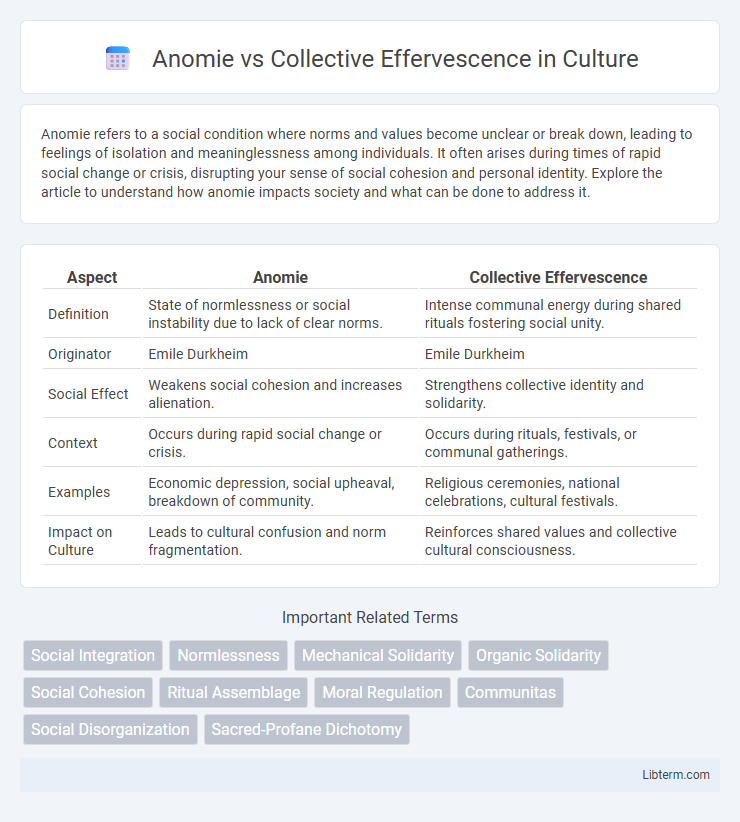Anomie refers to a social condition where norms and values become unclear or break down, leading to feelings of isolation and meaninglessness among individuals. It often arises during times of rapid social change or crisis, disrupting your sense of social cohesion and personal identity. Explore the article to understand how anomie impacts society and what can be done to address it.
Table of Comparison
| Aspect | Anomie | Collective Effervescence |
|---|---|---|
| Definition | State of normlessness or social instability due to lack of clear norms. | Intense communal energy during shared rituals fostering social unity. |
| Originator | Emile Durkheim | Emile Durkheim |
| Social Effect | Weakens social cohesion and increases alienation. | Strengthens collective identity and solidarity. |
| Context | Occurs during rapid social change or crisis. | Occurs during rituals, festivals, or communal gatherings. |
| Examples | Economic depression, social upheaval, breakdown of community. | Religious ceremonies, national celebrations, cultural festivals. |
| Impact on Culture | Leads to cultural confusion and norm fragmentation. | Reinforces shared values and collective cultural consciousness. |
Introduction to Anomie and Collective Effervescence
Anomie describes a state of social instability resulting from the breakdown of standards and values, leading to feelings of alienation and normlessness among individuals. Collective effervescence refers to the intense energy and sense of unity experienced during communal rituals or gatherings, reinforcing social bonds and shared beliefs. Both concepts highlight different responses to social cohesion and disruption within societies.
Defining Anomie: Origins and Meaning
Anomie, coined by sociologist Emile Durkheim, refers to a state of social instability resulting from a breakdown of norms and values, leading to feelings of alienation and purposelessness among individuals. It originates from the Greek word "anomia," meaning lawlessness, illustrating a condition where societal regulations become unclear or are no longer effective. This concept contrasts sharply with collective effervescence, which highlights the energizing and unifying power of shared rituals and community gatherings.
Understanding Collective Effervescence: Core Concepts
Collective effervescence arises when individuals in a group experience a shared emotional intensity that reinforces social bonds and collective identity, as described by Emile Durkheim. This phenomenon occurs during rituals or communal gatherings, generating a heightened sense of unity and transcending individual self-awareness. Understanding collective effervescence involves recognizing its role in fostering social cohesion and maintaining the vitality of collective consciousness within societies.
Historical Foundations: Durkheim’s Sociological Theories
Emile Durkheim's historical foundations of anomie and collective effervescence highlight contrasting aspects of social cohesion and disorder in modern societies. Anomie describes a state of normlessness and social instability arising from rapid social change or breakdowns in social regulation. Collective effervescence refers to the intense energy and shared consciousness experienced during communal rituals, reinforcing social solidarity and collective identity.
Psychological Impacts: Isolation vs. Social Connection
Anomie generates feelings of isolation and psychological distress by disrupting social norms and weakening individuals' sense of belonging, often leading to anxiety and depression. In contrast, collective effervescence fosters social connection and emotional uplift through shared rituals and group experiences, promoting unity and positive psychological well-being. These opposing phenomena highlight the critical role of social integration in maintaining mental health and resilience.
Social Structures: Normlessness vs. Social Solidarity
Anomie refers to a state of normlessness where social structures weaken, causing individuals to feel disconnected from societal values and leading to social instability. Collective effervescence represents the intense energy and shared emotions experienced during group rituals, reinforcing social solidarity and strengthening communal bonds. Together, these concepts highlight the contrast between social fragmentation due to a lack of norms and the unifying power of collective experiences in maintaining social cohesion.
Modern Examples of Anomie in Society
Modern examples of anomie in society manifest through rising social isolation, increased mental health disorders, and widespread distrust in institutions. Social media platforms, despite connecting people virtually, often exacerbate feelings of loneliness and fragmentation by fostering superficial interactions and echo chambers. Urbanization and economic instability contribute to weakened communal bonds, leading individuals to experience normlessness and a lack of shared purpose.
Contemporary Applications of Collective Effervescence
Collective effervescence, a concept coined by Emile Durkheim, manifests in contemporary society through large-scale social movements, concerts, and sporting events where shared emotional energy fosters social cohesion and group identity. This phenomenon contrasts with anomie, a state of normlessness and social instability often observed in fragmented modern societies lacking collective rituals. Digital platforms enhance contemporary collective effervescence by enabling virtual gatherings that generate synchronized emotional experiences, promoting solidarity despite physical distance.
Comparing and Contrasting Anomie and Collective Effervescence
Anomie, characterized by social instability and normlessness, contrasts sharply with collective effervescence, which embodies intense community solidarity and shared emotional energy. While anomie reflects a breakdown of social bonds leading to feelings of alienation and purposelessness, collective effervescence fosters social cohesion through communal rituals and shared experiences. These sociological concepts highlight opposing states of social integration, with anomie signaling disconnection and collective effervescence promoting unity and collective identity.
Conclusion: Implications for Social Cohesion
Anomie represents a breakdown of social norms leading to disintegration and individual isolation, whereas collective effervescence fosters shared emotional experiences that reinforce social bonds and group identity. Understanding these contrasting dynamics highlights the essential role of rituals and communal activities in mitigating social fragmentation and promoting cohesion. Effective social policies should therefore prioritize creating inclusive spaces for collective effervescence to counteract the alienation caused by anomie.
Anomie Infographic

 libterm.com
libterm.com